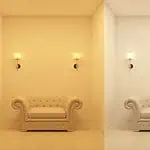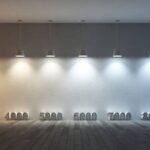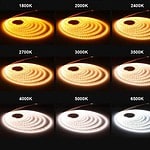LEDs are the most efficient solutions for commercial and residential lighting. Within LEDs, several types differ based on various factors, including color temperature. Color temperature is one of the critical factors you should be mindful of while picking a LED. While it can be simply described as the appearance of light, warm, or cool, there is a lot more to it.
5000K and 4000K are two of the most popular color temperatures used in commercial and residential spaces. If you are wondering how to pick one for your space, this article is for you. Let’s get to it.
Understanding LED Color Temperature
In simple terms, color temperature is a measure of the color of light. It is measured on Kelvin scale, which ranges between 1000K-10,000K. Technically, it is defined as the temperature of an ideal black-body radiator that emits light comparable to the hue of the light source pointed at it. Sounds complicated? Let’s break it down in a language you can understand.
Place a dark object at room temperature; it will appear black, which is obvious. Now heat the object at 1500 degrees Kelvin, and you will see that it changes its appearance to red. Notch the temperature up to 2700K, and you will notice the object glowing a warm yellow. At a temperature of more than 4200K, the object will appear white, turning blue as you go past 5500K.
Now that you understand the concept, let us tell you a cheat sheet to remember how color temperature can affect the glow of your light. Lights with a color temperature under 2900K emit a warm yellow light, whereas color temperatures of more than 3000K and 5000K offer a bright white and a cool white glow, respectively.
The appearance of light plays a critical role in the mood of people under it. Lights with a color temperature of less than 3000K trigger melatonin production in the body. It is a hormone that initiates sleep and hence makes people feel drowsy. Thus, these color temperatures are suitable for relaxing and resting spaces. In contrast, a color temperature of more than 4000K mimics natural light and stops melatonin production, making the people under it more alert and conscious.
For more information, you can read
How to Choose LED Strip Color Temperature?
Best Color Temperature for LED Office Lighting
2700K VS 3000K: Which One Do I Need?
3000K vs 4000K: Which Type of Lighting is Good For Home?
4000K Vs. 5000K LEDs: What Are The Differences?
Color
The basic difference between the 4000K and 5000K LEDs is the color of the light they emit. Since 4000K falls between blueish and red lights, it is more balanced and offers a warm white color. It is slightly less yellowish than lights with a color temperature of under 4000K.
5000K, on the other hand, falls higher on the spectrum and emits blue light. These lights do not even have a hint of yellow in them.
Mood
While both temperatures stop melatonin production in the body, the 5000K, because of the bluish light, does a better job of making people feel alert. It is precisely why 4000K is better suited for domestic uses while 5000K is used in commercial spaces.
| Feature | 4000K LEDs | 5000K LEDs |
| Color of Light | Neutral White (Cool White) | Daylight (Bright Cool White) |
| Mood | Relaxing, Comfortable | Invigorating, Alert |
| Applications | Offices, Retail, Schools, Hospitals, Living Areas | Workspaces, Studios, Garages, Outdoor Security, Display Cases |
| Ambiance | Welcoming, Easy on the Eyes | High Visibility, Color Accuracy |
Applications of 4000K LEDs
4000K LEDs are versatile and can be used in residential and commercial spaces. Typically, these lights are used in spaces where individuals must be alert. These include the following;
1. Kitchen
The kitchen is a space where you have to work with sharp objects. You must feel energetic and fresh while working there, which makes 4000K LEDs suitable for this space. Even though you feel energetic, this temperature still offers a relaxing vibe.
2. Offices
4000K LEDs balance a relaxing and energetic vibe, making them ideal for offices. Your employees will feel motivated to complete their work in a relaxing atmosphere.
3. Garages
You may not work with sharp objects in garages, but you will use many tools there, which warrants that you stay fresh. Using a 4000K LED will allow you to focus on work without feeling drowsy or bored while you are at it.
4. Retail Spaces
4000K lights offer a yellowish tint which makes the items in retail stores look exactly as if they are under natural light. It is more appealing for the customers, which drives the sales and consequently the profits of the retail stores.
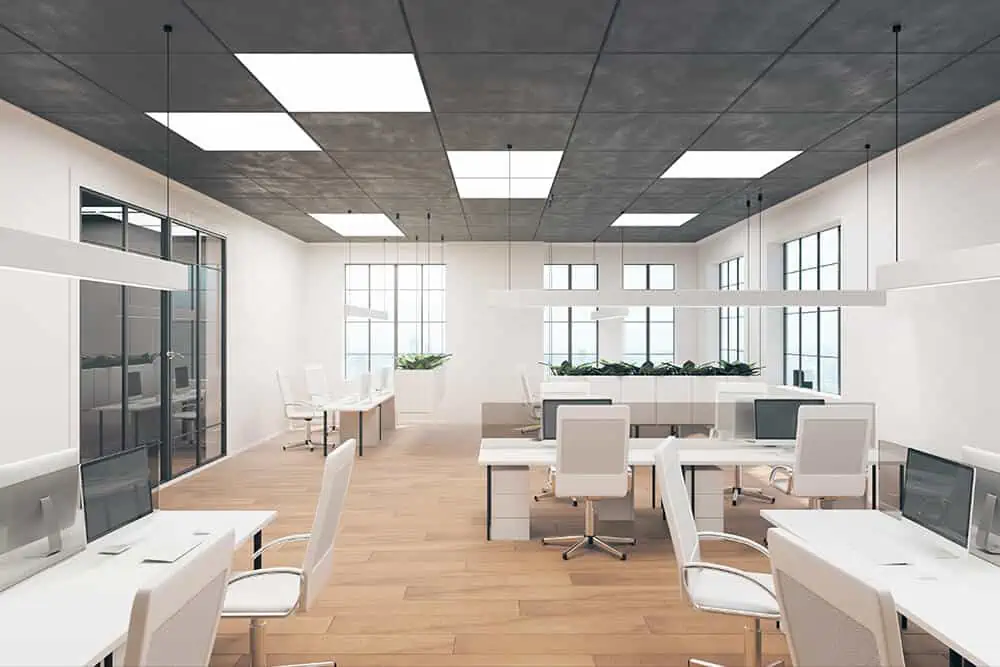
Applications of 5000K LEDs
5000K LEDs can be intimidating when used inside residential spaces, but they are ideal for commercial spaces, including;
1. Art Galleries
The neutral white color of 5000K lights enables the visitors to view the authentic colors of the paintings and sculptures displayed in the art galleries, making them perfect.
2. Showrooms
5000K LEDs augment the details of the object placed under it, making it a good fit for auto showrooms. Visitors can see the true colors and all the details of the automobiles before finalizing a purchase.
3. Stadiums
5000K LEDs are used in stadiums because they offer a perfect light source for photographers, especially in fast-paced games. It allows cinematographers and photographers to take shots in high definition.
4. Hospitals
Healthcare workers must have a clear view of what is happening around them, making 5000K LEDs perfect for healthcare settings. It allows healthcare professionals to see things in more detail.
5. Warehouses
5000K LEDs are also suitable for warehouses because they allow workers to see more detail and keep them fresh while working.

4000K vs. 6500K: An Additional Comparison
Understanding the differences between 4000K and 6500K LEDs, two popular color temperatures, can help you make an informed decision for various applications. Here is a more detailed comparison of the two, along with a table to showcase their differences.
Color 4000K LEDs produce a neutral white light with a hint of warmth, creating a balanced atmosphere. In contrast, 6500K LEDs emit a cool, blueish hue that closely resembles natural daylight, offering a daylight-like color.
Mood The comfortable and relaxing atmosphere generated by 4000K LEDs makes them suitable for both work and rest. Conversely, 6500K LEDs create an invigorating environment that enhances alertness and concentration, making them ideal for areas requiring high levels of focus.
| Feature | 4000K LEDs | 6500K LEDs |
|---|---|---|
| Color of Light | Neutral White (Cool White) | Daylight (Very Cool White) |
| Mood | Relaxing, Comfortable | Energizing, Highly Alert |
| Applications | Offices, Retail, Schools, Hospitals, Living Areas | Workspaces, Design Studios, Photography Studios, Task Lighting |
| Ambiance | Welcoming, Easy on the Eyes | High Visibility, Increased Color Accuracy |
In summary, both 4000K and 6500K LEDs have distinct characteristics that make them suitable for different applications. While 4000K LEDs are versatile and ideal for various spaces, 6500K LEDs are best suited for specific applications where high visibility and color accuracy are crucial.
How To Choose The Right LED Color Temperature
The first thing you need to do is figure out what you expect from space. Color temperature plays a major role in determining the vibe of a place. Thus, going wrong with it compromises its utility. You should pick lower color temperatures in spaces where you must relax or sleep, i.e., bedrooms and living areas. In contrast, you should go towards higher color temperatures in spaces designed for work, i.e., offices and garages. You can experiment with different color temperatures to find the best fit for a particular space.
How To Measure LED Color Temperature
Most reputed LED manufacturers write the color temperature in the description of their products, and most of the time, it is accurate. However, if you want to cross-check yourself, specialized tools are available. These include colorimeters and spectrophotometers. That said, these instruments can be expensive and may not offer value to users. You should use DIY solutions instead, which are inexpensive and provide accurate results.
In modern smartphones, the cameras are powerful, and with the right applications, you can know about the color temperature while pointing the camera toward the light. You can also photograph an object and use the applications to change the color temperatures in different pictures. Compare the photographs with the environment you see with the naked eye to identify the color temperature of light.
FAQs
The color temperature of 4000K is ideal for reading because it makes you feel energetic while promoting a relaxing atmosphere.
Lower color temperature triggers the production of melatonin, a hormone that regulates sleep. Exposure to these colors can make you feel drowsy during the day and disturb your sleeping pattern.
Plants require different color temperatures for varying functions. For example, they need red lights to flower, blue lights to promote vegetation, and red lights for overall growth. Combining these lights will help your plant grow better and quicker.
You can mix different color temperatures in the same room if different parts of the rooms are used for different functions. However, if the room is reserved for one operation, it is better to use one color temperature.
Depending on the look you want to achieve outdoors, LEDs with color temperatures between 2500K-4000K can be used for residential buildings. In commercial buildings, 5000K LEDs can also be used for outdoor lighting.
A particular diode’s color temperature specifies the color of its light output. In contrast, the color rendering index measures how well that diode can mimic natural light in terms of the colors of objects placed under it. CRI is measured on a scale of 1 to 100, while color temperature is measured on a Kelvin scale starting from 1,000K to 10,000K.
The look of the light generated is the fundamental distinction between 4000K and 5000K color temperatures. 5000K generates a chilly white light with a blue tint, whereas 4000K produces a warm white light with a yellowish tint. The color temperature, which is measured in Kelvin (K), determines the perceived warmth or coolness of a light source.
4000K generates a warm white light that is somewhat yellowish in appearance.
5000K provides a cold white light with a blue tint.
The temperature of the color is measured in Kelvin (K).
Color temperature plays a crucial influence in generating the desired mood in a room. Warmer color temperatures, such as 4000K, may produce a pleasant and appealing ambiance, making them excellent for living rooms and bedrooms. On the other side, colder color temperatures like 5000K may provide a brighter, more dynamic mood, making them perfect for workstations, offices, and commercial environments.
Warmer color temperatures provide a pleasant and inviting ambiance.
Lower color temperatures produce a brighter and more vibrant ambience.
The choice of color temperature can be based on the intended mood and purpose of the place.
The color temperature of a light source may dramatically effect human perception and mood. Warmer color temperatures, such as 4000K, are often connected with relaxation, serenity, and a sense of warmth. They can assist create a comfortable environment in residential settings. In contrast, colder color temperatures, like 5000K, are connected with improved alertness, attention, and productivity, making them excellent for work settings and task-oriented areas.
Warmer color temperatures are related with relaxation and a sensation of warmth.
Cooler color temperatures are related with alertness and enhanced attention.
The choice of color temperature can be determined by the desired effect on human perception and mood.
When deciding between 4000K and 5000K lighting, numerous variables should be addressed, including the function of the area, the intended atmosphere, and the influence on human perception and mood. It’s vital to evaluate the unique requirements of the area and the activities done there. For example, 4000K lighting would be good for home areas and locations where relaxation is required, whereas 5000K lighting would be great for workstations and commercial areas that demand enhanced attention and alertness.
Assess the purpose and function of the space.
Determine the ideal ambience and influence on human perception and mood.
Choose the proper color temperature depending on these parameters.
There are no intrinsic energy efficiency differences between 4000K and 5000K lighting, as the color temperature does not directly effect energy use. However, the impression of brightness may differ between the two color temperatures, which might possibly impact the quantity of lighting required for a particular room. Cooler color temperatures, such as 5000K, may produce a perception of greater brightness, perhaps allowing for lower wattage use or fewer fixtures to achieve the same level of illumination as a warmer color temperature like 4000K.
Color temperature does not directly effect energy efficiency.
The perception of luminosity may differ between the two color temperatures.
Cooler color temperatures may create an impression of greater luminosity.
Different color temperatures can affect the quality of sleep and the circadian rhythm. Warmer color temperatures, such as 4000K, have less of an effect on the production of melatonin, the sleep-regulating hormone. Therefore, using 4000K lighting in the evening and prior to bed may improve sleep quality. In contrast, cooler color temperatures, such as 5000K, inhibit melatonin production, making them unsuitable for use in the evening because they may disrupt the natural sleep cycle.
Melatonin production is affected less by warmer color temperatures.
Cooler color temperatures can inhibit the production of melatonin.
Utilizing warmer color temperatures at night may improve sleep quality.
The choice of color temperature can affect visual acuity and performance on a given task. Cooler color temperatures, such as 5000K, are known to improve visual acuity and performance in tasks requiring attention to detail, making them appropriate for workspaces, offices, and other task-oriented areas. Warmer color temperatures, such as 4000K, may not provide the same level of visual acuity improvement and may be more suitable for environments where relaxation and comfort take precedence over task performance.
Color temperatures that are cooler improve visual acuity and task performance.
Warmer color temperatures may not enhance visual acuity to the same extent.
In a given space, the choice of color temperature can be influenced by the desired level of visual acuity and task performance.
The use of 4000K or 5000K lighting may be advantageous for particular applications. For example, 4000K lighting is typically preferred in residential settings, hospitality spaces, and dining areas where a warm, cozy, and inviting atmosphere is desired. In contrast, 5000K lighting is favored in commercial spaces, offices, warehouses, and task-oriented areas, where a brighter, more energizing environment is required to promote concentration, productivity, and alertness.
In residential settings, hospitality spaces, and dining areas, 4000K lighting is favored.
In commercial spaces, offices, warehouses, and task-oriented areas, 5000K lighting is preferred.
The selection of color temperature should be determined by the application’s specific requirements and desired atmosphere.
The capacity of a light source to properly depict the colors of things it illuminates is known as color rendering. This skill is quantified using the Color Rendering Index (CRI). Both 4000K and 5000K lighting may produce excellent color representation, although the impression of colors may vary depending on whether the light is warm or cool. Warmer color temperatures, such as 4000K, can enhance red and yellow tones, and cooler color temperatures, such as 5000K, can emphasize blue and green tones.
Both 4000K and 5000K illumination can portray colors accurately.
Warmer color temperatures can accentuate yellow and red hues.
Blue and green hues are highlighted by color temperatures that are cooler.
Both 4000K and 5000K lighting may be utilized efficiently in outdoor settings, but each has pros and cons. With its soft white light, 4000K lighting may create a pleasant ambiance in home outside spaces such as patios, decks, and landscaping. Yet, it may not be as effective as 5000K illumination at boosting visibility and security. With its cold white light, 5000K lighting may improve visibility and is frequently used for street lighting, parking lots, and security lighting. Yet, its colder hue may not provide an environment as warm and appealing as 4000K lighting.
In outdoor residential settings, 4000K lighting produces an inviting ambience.
5000K lighting improves visibility and is appropriate for security and public lighting applications.
The selection of color temperature for outdoor applications must take into account both ambience and visibility needs.
When selecting lighting for any location, glare and visual comfort are crucial considerations. If not suitably diffused or veiled, both 4000K and 5000K lights can generate glare. Due to 5000K lighting’s cooler and brighter look, the feeling of glare may be more prominent. In order to reduce glare and assure visual comfort, it is vital to choose the proper fixtures, diffusers, and shielding, regardless of the color temperature.
If not suitably diffused or veiled, both 4000K and 5000K lights can generate glare.
With 5000K illumination, glare perception may be enhanced.
To reduce glare and maintain visual comfort, use the proper lighting fixtures, diffusers, and shielding.
4000K LEDs provide a balanced spectrum of light that can support plant growth. However, it is generally recommended to use LEDs with a full spectrum or a combination of different color temperatures for optimal plant growth.
4000K is a color temperature that represents a neutral white light with a hint of warmth. It is measured in Kelvin (K) and falls between warm white and cool white on the color temperature scale.
Lumens measure the brightness of a light source. The number of lumens produced by a 4000K LED light depends on the specific bulb’s wattage and efficiency, rather than the color temperature itself.
Brightness is determined by the lumens produced, not the color temperature. However, a 4000K light may appear brighter than a 3000K light due to its cooler and more neutral hue.
4000K is a color temperature and cannot be directly converted to lumens. Lumens measure brightness, whereas 4000K represents the color of the light produced by an LED bulb.
4000K lighting produces a neutral white light, while 5000K lighting emits a cool white light that closely resembles daylight. The mood and ambiance created by these color temperatures are also different, with 4000K being more relaxing and comfortable, and 5000K being more energizing and alert.
The choice between 3000K and 4000K depends on the intended application and personal preference. 3000K produces a warm white light suitable for relaxing spaces, while 4000K offers a neutral white light ideal for both work and rest.
For a shop, 4000K is generally recommended as it provides a welcoming atmosphere and is easy on the eyes. However, 5000K may be more suitable for certain applications where high visibility and color accuracy are important, such as displaying artwork or high-end products.
3000K LEDs produce warm white light, 4000K LEDs emit a neutral white light, and 6500K LEDs generate a very cool white light resembling daylight. These color temperatures create different moods and ambiances, making them suitable for various applications.
4000K LEDs emit a neutral white light, while 4500K LEDs produce a slightly cooler white light. The difference between the two is subtle, and the choice depends on personal preference and the intended application.
Conclusion
Color temperature is a critical factor that must be considered when picking up LEDs for residential and commercial buildings. It can impact moods, vibes, and the performance of individuals working under these lights. Lights with a color temperature under 4000K are best for residential buildings, while those above are more suited for commercial buildings. You should pick the color temperature based on the function of a space and the vibe you want to maintain. That is it for this article. We hope it has helped you understand the differences between 4000K and 5000K LED lights.
LEDYi manufactures high-quality LED strips and LED neon flex. All of our products go through high-tech laboratories to ensure the utmost quality. Besides, we offer customizable options on our LED strips and neon flex. So, for premium LED strip and LED neon flex, contact LEDYi ASAP!
